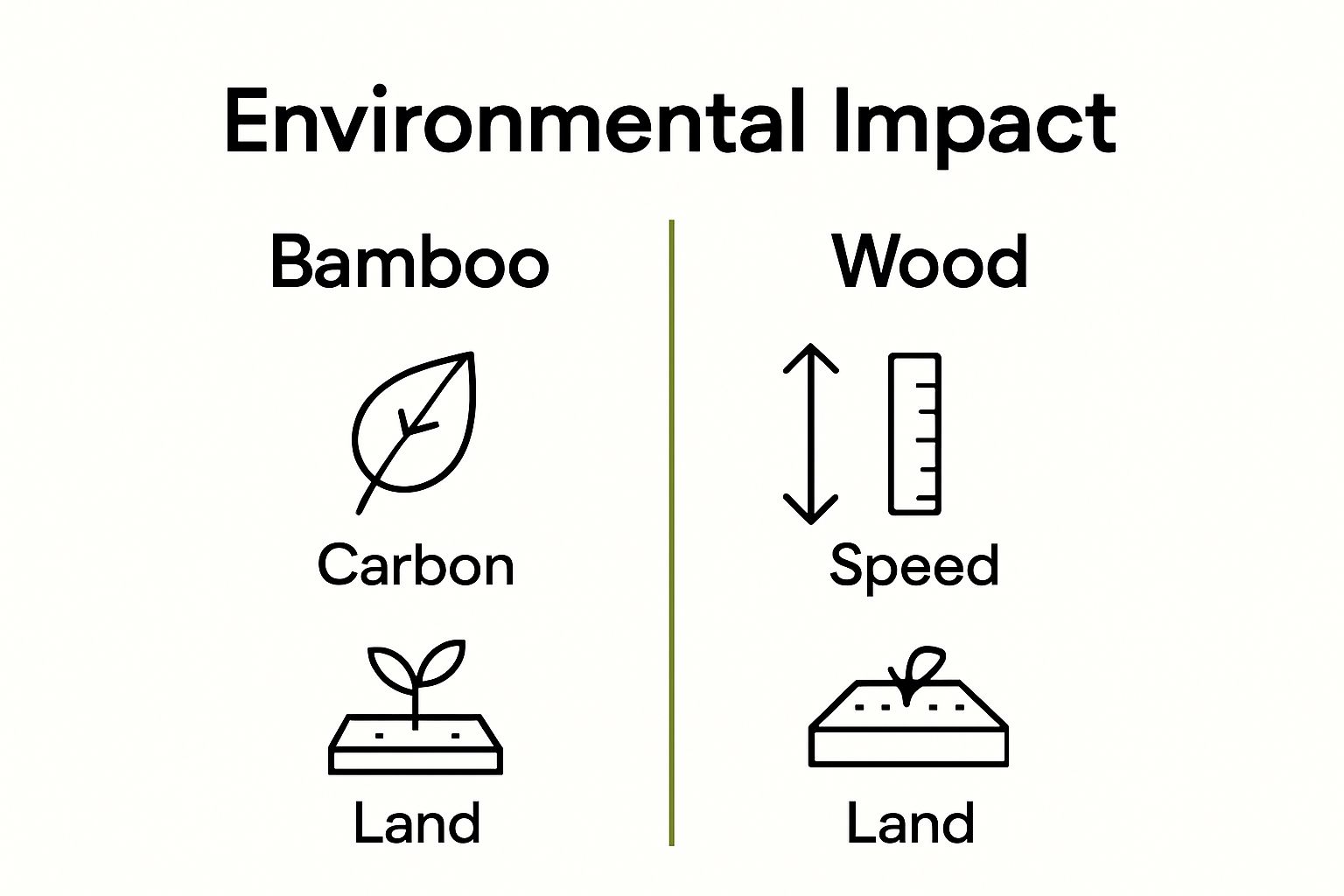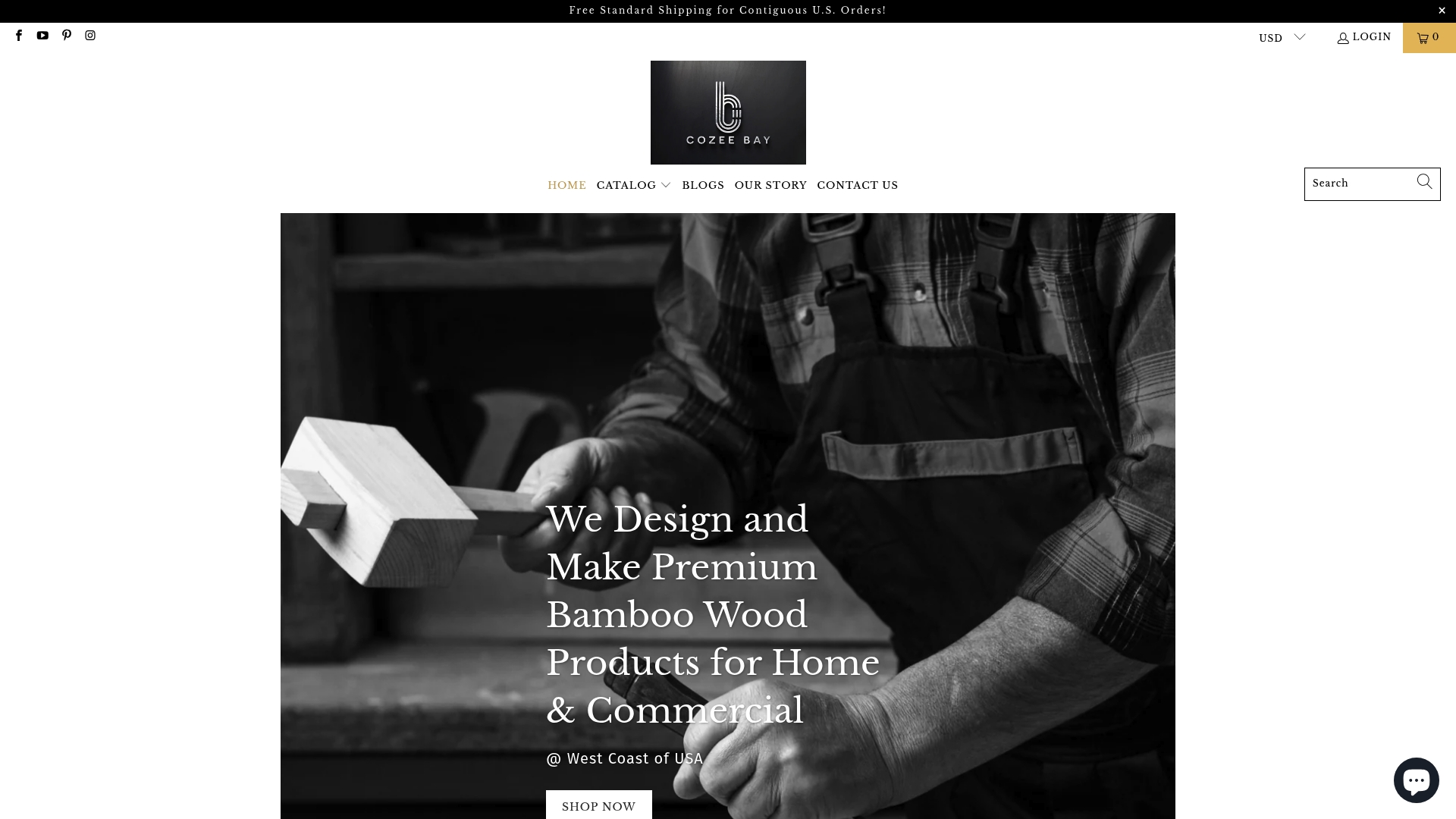Your Cart is Empty
Free Standard Shipping for Contiguous U.S. Orders!
Free Standard Shipping for Contiguous U.S. Orders!
Catalog

Understanding Innovations in Bamboo Products for Sustainability
October 11, 2025 8 min read
Bamboo products are rewriting the rulebook on sustainable materials. Most people think of bamboo as a simple plant or maybe as those decorative stalks in a vase, but the reality is wild. Bamboo can grow up to 1 meter a day and now powers everything from earthquake-resistant buildings to advanced automotive parts. That speed and strength put it leagues ahead of traditional timber, and new inventions are making bamboo a key player in high-tech, eco-friendly design.
Table of Contents
- What Are Bamboo Products and Their Innovations?
- Why Innovations in Bamboo Products Matter for Sustainability
- How Bamboo Products Are Made and Function
- Key Concepts Behind Bamboo as a Sustainable Resource
- Real-World Applications of Innovations in Bamboo Products
Quick Summary
| Takeaway | Explanation |
|---|---|
| Bamboo offers exceptional sustainability benefits | Bamboo’s fast growth and renewability lead to lower environmental impact and resource conservation. |
| Innovations enhance bamboo’s material properties | Advances like chemical modifications improve bamboo’s durability and make it competitive with traditional materials. |
| Bamboo supports carbon reduction efforts | Its high absorption rate of carbon dioxide contributes significantly to mitigating climate change impacts. |
| Bamboo products create economic opportunities | Recent developments in bamboo tech generate jobs and promote sustainable supply chains in rural areas. |
| Bamboo is versatile across industries | From construction to textiles, bamboo innovations are transforming product design and manufacturing practices. |
What Are Bamboo Products and Their Innovations?
Bamboo products represent a groundbreaking sustainability solution transforming multiple industries through innovative design and manufacturing techniques. Unlike traditional materials, bamboo offers extraordinary versatility, renewable characteristics, and exceptional performance across numerous applications.
The Essential Nature of Bamboo Products
Bamboo products encompass a wide range of items manufactured from this remarkably fast-growing grass species. From construction materials to household accessories, bamboo provides an eco-friendly alternative to conventional resources. Discover more about bamboo’s unique properties with materials that deliver both functionality and environmental responsibility.
Key characteristics of bamboo products include:
- Rapid renewable growth cycle
- Exceptional strength-to-weight ratio
- Natural antibacterial properties
- Biodegradability
- Low environmental impact
Technological Innovations Driving Bamboo Product Development
Recent technological advancements have dramatically expanded bamboo’s potential. According to advanced material research, scientists have developed sophisticated techniques like chemical modifications and fiber-reinforced composites that enhance bamboo’s mechanical properties. These innovations transform bamboo from a traditional craft material into a high-performance solution for industries ranging from construction to textiles.
Modern bamboo product innovations include engineered bamboo lumber, advanced textile fibers, composite materials for automotive components, and precision-crafted home accessories. Manufacturers now utilize cutting-edge processing techniques that improve durability, flexibility, and performance while maintaining the material’s inherent sustainability.
The convergence of traditional craftsmanship and modern engineering has positioned bamboo as a critical material in the global shift towards more sustainable and environmentally conscious product design.
Why Innovations in Bamboo Products Matter for Sustainability
Sustainability is no longer a buzzword but a critical global imperative, and bamboo product innovations are emerging as a transformative solution for environmental challenges. By reimagining traditional materials through technological advancements, bamboo offers a promising pathway towards more responsible resource utilization.
Environmental Impact and Carbon Reduction
Bamboo’s unique characteristics make it an exceptional sustainable material. Learn more about bamboo’s eco-friendly potential with innovations that significantly reduce carbon footprints. According to the United Nations Food and Agriculture Organization, bamboo products contribute substantially to carbon sequestration and environmental preservation.
Key environmental benefits of bamboo innovations include:

- Rapid carbon dioxide absorption
- Minimal land use requirements
- Significant reduction in deforestation pressures
- Lower carbon emissions compared to traditional materials
- Enhanced biodiversity preservation
Economic and Social Sustainability
Innovations in bamboo products extend beyond environmental benefits, creating substantial economic opportunities. By developing advanced processing techniques, manufacturers can generate employment in rural communities, support local economies, and create sustainable supply chains that align with global development goals.
These technological advancements enable the transformation of bamboo from a traditional craft material into a high-performance solution across multiple industries. From construction and automotive sectors to textile and consumer goods, bamboo innovations represent a holistic approach to sustainable development.
The strategic integration of bamboo technologies demonstrates how material science can drive meaningful environmental and economic progress, positioning sustainable innovation as a critical tool for addressing global sustainability challenges.
To help clarify the important environmental and economic impacts of bamboo innovations, the following table compares their specific benefits as described in the article.
| Area | Bamboo Innovations Benefit | Explanation |
|---|---|---|
| Environmental Impact | Reduced carbon footprint | Faster carbon absorption and less land use than timber |
| Carbon Reduction | Significant carbon sequestration | Bamboo absorbs high levels of CO2 per acre |
| Resource Conservation | Lower deforestation pressure | Renewable, rapid regrowth minimizes need to cut forests |
| Economic Sustainability | Job creation in rural areas | Manufacturing and supply chain development |
| Social Sustainability | Support for local economies | Income opportunities and sustainable development in communities |
| Industrial Applications | Versatility across multiple sectors | Used in construction, textiles, automotive, and more |
| Biodiversity | Enhanced habitat preservation | Minimal land disturbance and improved soil health |
How Bamboo Products Are Made and Function
Bamboo product manufacturing represents a sophisticated intersection of traditional craftsmanship and modern technological innovation. The process transforms raw bamboo into versatile, high-performance materials through precise engineering techniques that unlock the plant’s extraordinary potential.
Harvesting and Initial Processing
Explore the detailed manufacturing process of bamboo products, where sustainability meets advanced engineering. According to advanced materials research, bamboo product creation involves several critical stages:
Key processing stages include:
- Selective harvesting of mature bamboo stalks
- Careful seasoning to reduce moisture content
- Chemical treatment for pest and decay resistance
- Precision cutting and splitting techniques
- Advanced lamination and composite formation
Functional Characteristics and Applications
The manufacturing process transforms bamboo from a simple grass into a remarkable material with exceptional functional properties. Engineered bamboo products demonstrate superior characteristics that make them competitive with traditional materials across multiple industries.
Functional advantages of processed bamboo include:
- High strength-to-weight ratio
- Natural antimicrobial properties
- Superior flexibility and durability
- Excellent thermal and acoustic insulation
- Biodegradable and renewable composition
Modern bamboo product manufacturing employs advanced techniques like thermal modification, chemical treatment, and precision engineering. These methods enhance the material’s natural properties, creating products that perform exceptionally in construction, furniture design, textile manufacturing, and even specialized industrial applications.
This table summarizes the major functional characteristics of modern processed bamboo and highlights their advantages to support understanding of why bamboo is used for high-performance applications.
| Characteristic | Benefit/Advantage |
|---|---|
| High strength-to-weight ratio | Supports lightweight yet durable structures |
| Natural antimicrobial | Inhibits bacterial growth, ideal for hygiene uses |
| Flexibility and durability | Withstands stress without breaking easily |
| Superior thermal insulation | Maintains steady temperatures, energy-efficient |
| Acoustic insulation | Reduces sound transmission, enhances comfort |
| Biodegradability & renewability | Environmentally responsible end-of-life disposal |
The evolution of bamboo product manufacturing represents a remarkable example of how sustainable materials can be transformed through innovative design and technological expertise, offering environmentally responsible solutions across diverse sectors.
Key Concepts Behind Bamboo as a Sustainable Resource
Bamboo represents a revolutionary approach to sustainable resource management, offering an extraordinary alternative to traditional materials through its unique ecological and regenerative properties. Understanding its fundamental characteristics reveals why this remarkable plant is increasingly viewed as a cornerstone of environmental conservation strategies.
Ecological Growth and Regeneration
Learn more about bamboo’s sustainable potential and its exceptional environmental advantages. According to international research on environmental sustainability, bamboo possesses remarkable regenerative capabilities that distinguish it from conventional timber resources.
Key ecological characteristics of bamboo include:
- Rapid growth rates of up to 1 meter per day
- Ability to regenerate without replanting
- Minimal agricultural input requirements
- Extensive root systems preventing soil erosion
- Natural pest resistance
Carbon Sequestration and Environmental Impact
Bamboo’s environmental contribution extends far beyond its growth characteristics. This extraordinary plant plays a significant role in carbon capture and climate change mitigation, functioning as a powerful natural carbon dioxide absorber and oxygen producer.
Environmental benefits of bamboo include:
- Higher carbon dioxide absorption compared to equivalent tree stands
- Significant oxygen production
- Minimal land use requirements
- Enhanced biodiversity support
- Natural soil restoration capabilities
By combining extraordinary growth potential with substantial environmental benefits, bamboo emerges as a transformative sustainable resource. Its ability to provide economic value while simultaneously supporting ecological restoration positions it as a critical solution in global efforts to develop more responsible and regenerative material systems.
Real-World Applications of Innovations in Bamboo Products
Innovative bamboo technologies are revolutionizing multiple industries by offering sustainable, high-performance solutions that challenge traditional material paradigms. From construction and design to advanced manufacturing, bamboo products are demonstrating remarkable versatility and environmental potential.
Construction and Infrastructure
Discover innovative bamboo applications across diverse sectors. According to sustainable materials research, bamboo innovations are transforming architectural and infrastructure design through advanced composite materials and engineering techniques.
Key construction and infrastructure applications include:
- Earthquake-resistant building structures
- Sustainable architectural paneling
- Reinforced concrete alternatives
- Lightweight infrastructure components
- Eco-friendly scaffolding solutions
Consumer Products and Industrial Innovations
Beyond traditional uses, bamboo products are expanding into sophisticated consumer and industrial domains, offering environmentally responsible alternatives to conventional materials. Advanced processing techniques have enabled bamboo to become a high-performance material across multiple sectors.
Diverse bamboo product applications encompass:
- Biodegradable packaging materials
- Sustainable textile fibers
- Disposable and compostable tableware
- Advanced automotive components
- Precision medical and scientific equipment
The strategic integration of bamboo innovations represents a pivotal shift towards more sustainable industrial practices. By combining exceptional material properties with environmental consciousness, bamboo technologies are creating pathways for more responsible resource utilization across global manufacturing and consumer product landscapes.

Discover Sustainable Bamboo Innovations for Your Everyday Life
Have you ever struggled to find household products that are truly sustainable and still deliver on style and function? As explored in the article, innovations in bamboo products answer today’s urgent need for eco-friendly solutions by combining advanced technology and renewable resources. If you are looking for ways to reduce your environmental impact while enjoying elevated design, our bamboo paper towel dispensers bring these innovations directly into your home or business, replacing single-use plastics and cheap alternatives with craftsmanship you can trust.

Make the transition to a cleaner, smarter, and more responsible way of living. Visit Cozee Bay’s main website or explore our plastic wrap dispenser collection to see how easy it is to align your daily routines with your sustainable goals. Our fast shipping and quality guarantee mean now is the perfect time to upgrade to durable bamboo solutions while supplies last.
Frequently Asked Questions
What are the environmental benefits of innovations in bamboo products?
Innovations in bamboo products help reduce carbon footprints significantly due to bamboo’s rapid growth and high carbon dioxide absorption rates. To leverage these benefits, consider integrating bamboo materials into your next design or construction project to enhance sustainability.
How can I integrate bamboo materials into my construction projects?
To integrate bamboo into construction, start by researching engineered bamboo lumber or composite materials that offer durability and strength. Using bamboo can not only reduce material costs but also lower the overall environmental impact of your project.
What are the unique properties of bamboo that contribute to its sustainability?
Bamboo is known for its rapid renewal cycle, natural antibacterial properties, and biodegradability. Explore how these properties can enhance the functionality of your products while minimizing ecological footprints.
What processing techniques enhance the performance of bamboo products?
Advanced processing techniques such as thermal modification and chemical treatments improve bamboo’s durability and flexibility. Implement these techniques in product development to ensure high-quality, long-lasting bamboo items.
How does bamboo compare to traditional materials in carbon sequestration?
Bamboo absorbs more carbon dioxide than many traditional timber resources due to its fast growth rate and extensive root system. Take advantage of bamboo’s superior carbon sequestration capability by incorporating it into your sustainability practices, aiming for a measurable reduction in carbon emissions.
What industries are benefiting from bamboo innovations?
Innovative bamboo products are making significant impacts in industries like construction, textiles, and consumer goods. Identify specific applications within these fields to enhance sustainable practices and reduce reliance on less eco-friendly materials.
Recommended
Leave a comment
Comments will be approved before showing up.
Subscribe
Sign up to get the latest on sales, new releases and more …

